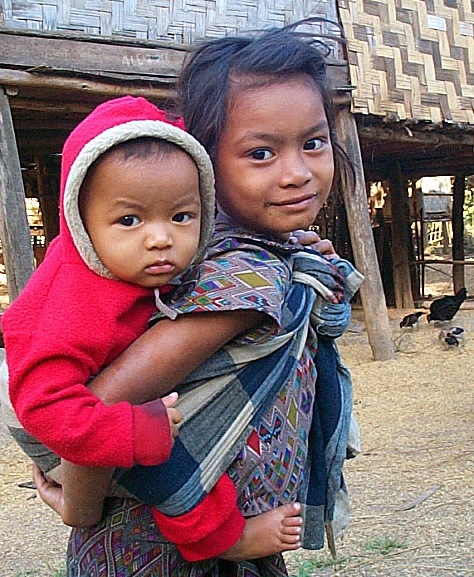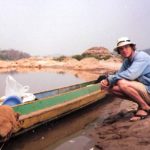Central Laos has all the makings of travel’s last frontier: An unmapped wilderness, a lost city, villagers unaccustomed to visitors. What’s at stake when tourists arrive?
By Rolf Potts
We hike out of the trees and into the shadow of the towering gray cliff, yet even then the entrance to Heup Cave is difficult to make out until we are standing directly in front of it. Then, suddenly, it looks enormous — a rocky yawn of cool air, clean water, and darkness.
The only way into or out of central Laos’s Na Valley, our porters tell us, is through this flooded cave, which reputedly stretches more than half a mile under the limestone ridge. Max Arcangeloni, our leathery forty-two-year-old expedition leader, logs a reading on his GPS. In the three days since we crossed the Mekong River from Thailand, Max has been meticulously recording cultural and geographical features along the rocky fringes of the Khammouan Limestone National Biodiversity Conservation Area. The Khammouan does not feature in any history or travel books and has yet to be comprehensively surveyed. This trip is the first attempt to chart it.
Now, having taken our small expedition team fifty miles on foot and by boat up the Hin Boun River, Max is facing a moment of truth. On the one hand, the valley on the other side of the cave could be just another anonymous wrinkle in the landscape of Southeast Asia. Then again, the Na could very well live up to its reputation as the home of pristine forests, abundant wildlife, the primitive village of Ban Na, and the vine-entangled ruins of a mysterious old city named Aran.
Despite all appearances, however, we are not hauling two hundred pounds of computer equipment, digital cameras, satellite mapping technology, dried food, and climbing gear through Heup Cave in the name of historical or scientific exploration. Rather, Max has been hired by North by Northeast Tours, a Thai travel company, to survey and map the area so that it can be opened up to sustainable tourism. Whatever biological, geological, anthropological, or archaeological curiosities we find will be recorded primarily as potential expedition highlights. I’ve been trudging along jungle footpaths and boating my way up Mekong tributaries to witness the early development of what is (for the time being, at least) the last frontier of travel. Here, as Max systematically gauges the ecotourism possibilities of the Laotian backcountry, I hope to see how a mere location begins to transform into a destination.
Muntree Paorman, Max’s Thai assistant, distributes headlamps to the Lao porters. Giggling at the battery-powered novelty, the teens hoist their loads and wade into the darkness of the cave. I splash into line behind Muntree and Max as the porters’ yellow beams of light dance up onto the smooth rock of the cave entrance. After twenty minutes of sloshing our way along the dark stream, we ascend small wooden ladders that lead us up to smooth stone paths worn into the limestone. Cast-off bundles of charred sticks that have been used as torches by recent commuters dot the fringes of our route. Twenty feet up the cave wall, a thin line of mud marks the monsoonal high-water point. Even in complete darkness, pink-leafed shoots of bamboo push up from the stream banks, delicately tilting toward the cave entrance.
After nearly an hour of wading through the darkness, we finally scramble over a jumble of damp boulders and into a blinding slot of daylight. Outside, the mountain-ringed Na Valley reveals itself in a sudden wash of late-afternoon color: green jungle, brown earth, gray rock, blue sky. Teak trees tower up through the canopy, and leaves blanket the forest floor. The air, I note, is more humid than on the Hin Boun side of the cave. A path leads away from the limestone ridge and into a thick stand of hardwoods and tangled underbrush. As we walk, I am filled with nervous anticipation over what awaits us. I also wonder what will happen to the valley once Max collects his data and reports home. After all, this visit stands to change the place forever.
In many ways, tourism is a perfect industry for Laos, a landlocked communist country that has only been open to foreigners since 1989. Unlike its crowded and industrious neighbors (Thailand is home to 54 million people; Vietnam’s population is 75 million and growing), Laos has just 5 million citizens and very little commerce or infrastructure. Seventy percent of the land consists of mountains or high plateaus, and 25% of Laos is blanketed in primary forest — making it the most pristine country in Indochina. Perhaps seeing value in this, the Laotian government set up 17 national nature reserves in 1993 (including Khammouan Limestone NBCA), earmarking 10% of the Laotian landmass for conservation. And despite the fact that most of these conservation areas are still largely inaccessible, tourism became the top foreign-exchange earner in Laos for the first time in 1999. Theoretically, nature-based ecotourism ventures within the conservation areas could further bolster the Laotian economy at the same time that they preserve the Laotian environment.
The problem with ecotourism anywhere, however, is that it’s a difficult activity to define, and an even harder activity to regulate. At a simple level, ecotourism is responsible travel that conserves the natural environment and sustains the well-being of the local-people — but even this basic definition can prove full of contradictions and loopholes. For example, ecotourism seeks “unspoiled” places that have not been categorized or prepared for tourist consumption, yet ecotourism itself is a form of categorization and consumption. Ecotourism promises an escape from the trappings of affluence and information society, yet by attracting affluent tourists to isolated points around the globe, ecotourism spreads the gospel of information society. And while the purpose of ecotourism is to preserve the culture and ecology of exotic places, the most efficient way to achieve this is to not travel to those exotic locales in the first place.
In a practical sense, ecotourism isn’t the product of design so much as it is the result of market demands. Just as Thomas Cook’s pioneering tour-organizing efforts 150 years ago catered to the emerging social and recreational needs of a new industrial age middle-class, ecotourism is a response to information age yearnings for uniqueness, isolation and authenticity. Thus, where the traditional aim of tour developers has been to create an exotic, leisurely variation of Paradise, ecotours aim to package a postmodern sort of Wonderland — a place that remains unique to itself, quietly tucked away from the unifying juggernaut of global culture. And such exotic, anonymous isolation is becoming a hot commodity. Depending upon whose statistics you choose to believe, ecotourism has grown to encompass five to thirty-five percent of a tourism industry that generates $2.5 trillion of commerce a year.
Of all the novelties that greet us in Ban Na, the most curious is the village headman’s request that we purchase a pig. It seems that this gesture is just a cumbersome method of paying for our room and board, but Max is a bit stumped about what we’re expected to do with the pig. I keep imagining him forlornly hiking through the forest with a squealing porker strapped to his backpack.
Ban Na itself is little more than two dozen rattan-walled huts perched on stilts in a small clearing. We’ve arrived during the harvest, and beneath the houses, several old women are threshing rice with big wooden pounders that tilt like seesaws. Most of the villagers are off tending their fields, leaving the dusty lanes of Ban Na to a handful of elderly women, very young children, and a few skinny dogs and chickens. A tiny, straw-roofed schoolhouse sits, half-collapsed, at the edge of the settlement; the headman tells us that classes haven’t been held since the teacher stopped coming through the cave from Ban Nakok a few months ago.
Bidding our porters farewell (all of them live in the Hin Boun basin and will return home through Heup Cave while it’s still light out), Max, Muntree, and I prepare for a night in Ban Na. It is an unspoken assumption that we will sleep on the porch of the headman’s house. The interior of the wood-framed hut is bare save for blankets, clothing, a few mosquito nets, and some faded government-issue public health posters; cooking is done over an open fire in an adjacent outhouse. By all appearances, life is so basic here that I find it hard to believe that Aran — reputedly once a sophisticated settlement — could ever have arisen in this valley. Max, speaking Thai and pidgin Lao, jokes with the small children who’ve crept up to stare at us.
Indeed — satellite mapping notwithstanding — forging such bonds of goodwill is his most important task here. After all, the locals will know the nuances of the area better than Max’s GPS does, and any tour groups that arrive here in the future will depend on their hospitality. In the coming days, he will train various villagers in the art of aesthetically correct trash disposal, slit-latrine construction, and other low-impact methods of hosting visitors. But for now, Max gets out his medical kit and squats at the foot of the headman’s house. As people return from the fields in the evening, he attends to their various aches and pains with aspirin and antiseptic.
The sixteen-year-old daughter-in-law of the headman brings him her month-old son. In a soft voice, she explains that the baby has not been taking her breast milk. Lifting the yellow swaddling blanket, she shows how his tiny face has begun to wrinkle from malnutrition. Max suggests that the child be taken through the cave to a clinic downriver, but the headman shrugs off the idea. Perhaps because infant mortality can be as high as twenty-five percent in settlements like Ban Na, babies are not regarded as full humans until they are old enough to have an active interest in their surroundings. And because the merits of Western neonatal medicine are not understood, it appears that the villagers are prepared to leave the baby’s health to local resources. Hoping to help somehow, Max prepares a powdered cocoa solution for the infant.
By nightfall, all hundred or so villagers have returned, and Ban Na is abuzz. Most of the people have never seen falangs (non-Asian foreigners) before, and the residents are positively enamored of us. One toothless old lady — who, we find out later, is just fifty-four years old (ancient and matriarchal by Ban Na standards) — solemnly walks up and presents us each with a boiled egg. Max delights them by taking photographs with his digital camera and displaying the images on his laptop.
The people of Ban Na don’t conform to the sentimental tourist’s idea of what isolated villagers should look like. Instead of colorful ethnic costumes, they sport tattered T-shirts, rubber sandals, Chinese-manufactured woolen trousers, and grimy army jackets. Even the women’s wraparound skirts have been fashioned out of mass-produced printed fabrics that probably trickled in from Thailand.
Similarly, there is nothing rich or exotic about the food here. As far as we can tell, wild fruit does not grow in the Na Valley, and the people of Ban Na don’t maintain much of a vegetable garden. There are some banana groves nearby, but none of the fruit is ripe right now. Fish, rodents, birds, and even bats are regularly trapped or hunted; on rarer occasions, one of the chickens or dogs is butchered. Thus, tonight’s meal of sticky rice, bamboo hearts, and one stringy hen is an enviable feast for these villagers. For Max, Muntree, and me, however, it feels more like an appetizer. We have instant noodles and dried pork among our supplies, but we let our stomachs grumble out of courtesy to our hosts.
Though Max and Muntree know enough Lao to chat with the adults after dinner, I am forced to resort to other forms of interaction. Since a third of the village is made up of small children, I gather a giggling horde of kids around a bonfire and valiantly attempt to teach them “Old MacDonald Had a Farm.” Before long I can recognize the braver kids by their personalities. In my mind, I’ve given them all nicknames: The doe-eyed eight-year-old waif who preens her way through the proceedings and giggles coyly when I wink at her is Miss Zha-Zha; the handsome ten-year-old who shows me the hand-fashioned trap he uses to catch rodents is Little McGuyver; the naked, scowling six-year-old who skulks around the fire with dirt stuck to his face is Pigpen. By the light of the fire, I feel that Ban Na has grown larger. What by day was a dusty, forlorn village has now become intimate and vividly alive.
Should the ruined city of Aran prove to be more than a rumor, I think as I watch the village settle down for the night, North by Northeast Tours will have a marquee draw to go along with all the area’s organic charms, and this expedition will be an automatic success. But once Aran becomes a regular stop on the ecotour circuit, life in Ban Na stands to get a lot more complicated.
Shortly before joining the expedition, I visited North by Northeast’s office in Nakhon Phanom, on the Thai side of the Mekong. There, I met with Nick Ascot, the hyperkinetic Canadian who founded the company. “I’ve been running tours in Thailand for more than two years,” he told me. “And that whole time, I’ve been looking out across the river at those mountains.” He nodded toward the distant karst on the Laotian side of the Mekong. “I mean, here we ran a tour company next to one of the world’s most impressive biodiversity areas, and nobody seemed to know anything about it.”
By questioning local residents and foreign NGO workers, Nick was able to collect enough secondhand information (including rumors about Aran) to justify a formal expedition into the area. Since he didn’t have the time or the experience required to explore it himself, he hired Max. That both men make their living in Thailand is telling: The country has been Southeast Asia’s most stable and profitable tourist market for the last thirty years. Adventure trekking has been a lucrative niche market in Thailand since the early 1970s, when local guides in the northern mountains began to lead small groups into wilderness areas and ethnic villages. In time, these treks grew so popular that Chiang Mai (typically the staging area) became a tourist hub rivaled only by such canonical draws as Bangkok and Phuket. By the mid-1990s, primitive settlements that had never seen a Western visitor before the Vietnam War were hosting up to thirty-five a night during the dry season.
Tourism transformed northern Thailand. It raised the standard of living for tribal minorities and encouraged the government to build more roads and public facilities. But the hill tribesmen didn’t seem so authentic once they started to watch television and eat Pringles. In order to compensate for this eroding “authenticity,” trekking companies started to import and invent new attractions: elephant rides, raft trips, opium tents. Bangkok-based tour companies began to wrest business away from local operators, and “hill-tribe rituals” were staged to keep up with the demand. In 1997, wily tour organizers were charging tourists six dollars to take photos of the giraffe-necked Padaung women on the Burmese border; in 1999, a trekking company was prosecuted for adding prostitution to its backcountry repertoire.
Nick was unfazed when I pointed out such shortcomings in the Thai trekking industry. “So many of Thailand’s best spots have been ruined because the tourism was unplanned and unregulated,” he told me. “My idea in Laos is to get in on the ground floor — for the sake of my business, yes, but also to encourage sustainable tourism in an area so close to home.”
“But,” I said, “isn’t it better — ecologically and culturally speaking — to leave the place to itself?”
Nick thought for a moment, then shook his head. “If we don’t explore and sell it, others will,” he said. “And if we can agree that change is coming no matter what, then to ignore its approach is wrong. I feel that those of us who care about the place will have a chance to contribute constructively when those changes come.”
Our second day in Ban Na begins at 4:30 a.m., when the chickens start screaming and the villagers stir for another day of harvest. Bleary-eyed, I climb down from the headman’s porch and join Max. “Muntree and I have a meeting with the headman this morning,” he tells me.
“Will you ask him about the Aran ruins?”
“Probably. We have many things to discuss.” Max shoots me a wry look. “For example, we should probably discuss why he wants us to buy a pig.” I don’t understand enough Lao to follow the proceedings, so I wander out into the village. A gaggle of children greets me with jumbled refrains of e-i-e-i-o. Little McGuyver happily leads a pet monkey around on a fraying twine leash. The day has just begun to color the sky above the ring of mountains that encloses the valley, and the morning air is damp, cool, and slightly smoky. I can hardly describe the atmosphere here: I’ve tasted remoteness before, in the desolate Libyan Desert and on the empty steppes of Mongolia, but this human-inclusive isolation is different — and almost magical. At times it feels as if I’m walking through a dream.
Max climbs down from the headman’s house, and from the look on his face, I can tell something’s up. “The headman says he’s going to take a special trip through the cave when he gets some time,” Max tells me. “He wants to buy our pig from Nakok village.”
“Did he say what we need it for?”
“A sacrifice,” he says, gesturing at the mountains that surround us. “I guess as visitors we need to be ‘introduced’ to the spirits of the valley. I think it’s an animist version of a welcome party. The villagers know where the ruins of Aran are,” he adds with characteristic nonchalance. “We’ll go there this morning.”
Within an hour, we’ve packed our surveying gear and departed for the ruins. Although the Aran site is said to be close to Ban Na, our journey into the forest becomes somewhat complicated. Every time we get a good hiking rhythm going, the headman scampers off into the trees and returns with some type of root or resin. To my eyes, the dense Na Valley jungle is gorgeously cluttered and indecipherable, but to the people who live here, it is an enormous, leafy convenience store. The headman seems particularly pleased when he finds a thick vine that he calls kheua yan-nang, whose bark, he says, can cure insomnia when boiled into a tea.
The more he dallies, the more I suspect that Aran will prove to be little more than a few decade-old abandoned bamboo huts. Though supposedly an ornate stone city swallowed up by the jungle of the Na, Aran sounds like a fairy tale. After all, urban settlements have never been common this far inland from the Mekong.
My skepticism, however, does not last much longer. Less than two miles outside Ban Na, we veer just a hundred yards off the path to discover a square gray pillar tilting out from a small stand of trees and vines. The pillar is part of a mossy, mostly decayed brick-and-mortar temple building. Atop the small temple mound, toppled circular pillars and stray red bricks share space with rotting leaves and vigorous shrubs; tree roots as thick as my leg zigzag through the brickwork foundation.
On the far side of the mound, a second square pillar has fallen to the ground, its once-ornate lotus-flower fluting pressed deep into the mud.
While Max photographs the ruins with a digital camera and marks our location on the GPS, Muntree and I search for more Aran remnants. We find another group of the toppled round pillars and a small pile of bricks but nothing that compares with the temple mound. In all likelihood, it was the city’s only brick-and-mortar building, and whatever other structures once stood here are long gone. The headman picks up a brick and says that the mud used to make it was probably carried in through Heup Cave. A smaller cave nearby, he adds, served as an oven to bake the bricks. Aside from this, however, he doesn’t seem to know anything about the site. Indeed, we have yet to meet anyone (or find any literature) that can tell us about its origins. Consequently, Aran tantalizes visitors into doing their own circumstantial-historical detective work. Since the site is not terribly old (less than two hundred years, it seems, given its architectural similarity to nineteenth-century temples in the Mekong Valley), I’d wager that Aran was built as a refuge for besieged Mekong Valley Lao during the Thai-Vietnamese power struggle in the 1830s. At that time, the local Lao seemed likely to sympathize with the Vietnamese in the event of war, so the Thais began a policy of forced relocation in the Mekong. For fifteen years, with entire villages seized and moved to Thai territory, Lao families sought refuge in the rugged limestone mountains of what is now central Laos.
The Pheun Vieng Chronicle, a poetic historical account of the period, vividly speaks of these dramatic events: “The Lao . . . escaped through the mountain crevices, / Crawling up the cliffs of the highest peaks, / Hiding in those mountains, / There only to be followed, captured, and bound.”
I can imagine how the temple (and the city that once surrounded it) might have been built as a sanctuary. Heup Cave would have provided a natural defense and camouflage against the Thai raiders, and the brickwork technology could have been imported from a more sophisticated Lao settlement in the Mekong Valley. Looking at what’s left of the site, I wonder if Aran was evacuated peacefully when the relocation raids ceased or if it met a violent end at the hands of Thai invaders. I can’t be sure of this theory, of course, but I find giddy fascination in the idea that Aran could be the most dramatic physical evidence of that violent era in Lao history: a silent, brick-and-mortar Pheun Vieng Chronicle that sits draped in moss, waiting to be read.
As far as Max is concerned, the history will sort itself out. Aran neatly completes the equation that will make the Na Valley a key attraction for North by Northeast Tours. He remains stoic on our hike back to Ban Na, but his enthusiasm occasionally shines through. “If you talk to Nick before I do,” he says to me, “tell him that this valley is a gold mine.”
It’s not until our final night in Ban Na that we are reminded about the sacrificial pig and the jealous spirits of the Na Valley. We have been joined by Knut Bry and Gilles Tondini, who’ve come to photograph the expedition. Now that four falangs are staying in the village, our evenings have taken on a kind of carnival atmosphere. Tonight, I continue my efforts to teach the kids “Old MacDonald,” while Knut instructs a group of teenagers in the art of the high five. In the headman’s hut, Max types on his laptop in front of a rapt audience of two-dozen villagers. We have proved to be as much of an attraction for the people of Ban Na as this valley is for us.
We are halfway through our dinner of boiled chicken and sticky rice when the moaning starts. At first I think it’s a sick dog, but then I notice that people are congregating at the door of a neighboring hut. Max asks a few questions in Lao, then trots off to get his medical kit. “Sounds like someone has food poisoning,” he tells me. I follow him up onto the porch, but the villagers stop us at the door. Inside, I see an alert old man casually pressing loose tobacco into a square of notebook paper. Across from him, a wild-eyed woman rocks back and forth in front of a flickering oil lamp, groaning loudly in rhythm with her movements. Still nonchalant, the old man rolls up his cigarette and begins to talk soothingly to the woman. Timing his syllables to the rhythm of her motions, he looks her in the eye as he lights his cigarette in the flame of the oil lamp.
Max interprets the situation for me in bits and pieces. Apparently, the moaning woman has been possessed by phii — the spirits of the valley. The man with the cigarette is the shaman, and he’s trying to determine what the spirits want. Gradually (and somewhat chillingly), it is revealed that the spirits are upset by the presence of the four falangs. Because the Ban Na headman didn’t have time to go through the cave and buy a sacrificial pig from Nakok, we were never properly introduced to the phii. Moreover, the spirits didn’t even know of us until one of the village boys shot stones at some jungle birds when we were hiking through the valley that afternoon. The birds apparently spilled our secret—and now the spirits want to know who we are and why we are here.
The moaning lasts long into the night, and I have trouble falling asleep. At one point, I climb down from my corner of the headman’s porch and — perhaps because of the spirits, or maybe out of random workaday sickness — vomit onto the Ban Na dirt.
When the sun finally comes up, our group begins to prepare for the planned hike out of Na Valley. One of our last items of business it so pass out a few gifts — t-shirts, notebook paper, butane lighters — to the villagers. Max prepares a supply of powdered milk for the headman’s baby grandson. Once Max has finished giving preparation instructions to the young mother, I ask him how he thinks the village will change once tourists start to come. “I’m a pessimist,” he replies, “especially in this part of the world. Tourism is a shortcut to development; things happen too fast.”
Since I’ve always taken Max for a grizzled idealist, I challenge him a bit. “By the time that sick baby becomes a teenager,” I offer, “tourism could be giving him access to the sort of health and education that these people have never dreamed of.”
“Yes,” Max says. “But he’ll be getting his dreams from television and the outside world. He’ll lose interest in this valley and move to Thakhek or Vientiane because there’s more money there. I’ve seen it happen before, and I can’t see how it will be any different here.”
An hour later, we finish packing our group gear, hire half a dozen villagers as porters, and hike out of the Na Valley. In another week, we’ll receive word that the headsman’s infant grandson has died.
Though frequently used (and awe-inspiring) Heup Cave is not the only way out of Na Valley. Southeast of Ban Na, a second trail zigzags up one of the lower ridges and leads us onto a plateau fringed with razor-like limestone peaks. Beyond the valley, we encounter quirky villages, the dust-covered French colonial hill station of Phontiou, and an eccentric array of natural wonders.
Seven days after having left Ban Na, we emerge from the wilderness near Konglo Cave, which, because it gets about five visitors a month during the dry season, is currently the most heavily touristed destination in the entire Oahu-sized expanse of the Khammouan.
Just a few valleys east of Konglo Cave — in a region far more isolated than any place I’ve visited in recent days — lies the Nakai-Theum River NBCA, the largest of its kind in Laos. Stretching along the mountainous border with Vietnam, the Nakai-Theum River reserve is over twice as large as the Khammouan Limestone NBCA, and features clouded leopards, wild elephants, Indochinese tigers and scattered hilltribe settlements representing 28 different ethnic groups. If, as has been suggested, these two central Laotian reserves were linked with the Hin Namno NBCA (an important primate conservation area) to the south, Laos would find itself home to one of the most important biological and cultural conservation regions in the world. In this way, central Laos is like an equation waiting to be added up — and for now, it’s too soon to say how tourism will factor in.
The only thing I can say for certain is that the arithmetic has begun.
This article originally appeared in the January 2003 issue of Conde Nast Traveler.






